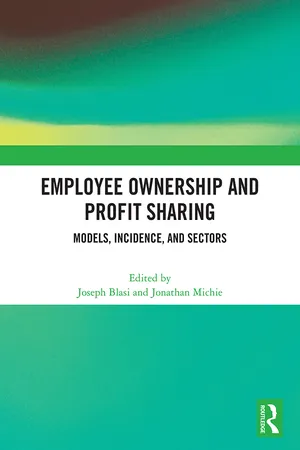
Employee Ownership and Profit Sharing
Models, Incidence, and Sectors
- English
- ePUB (mobile friendly)
- Available on iOS & Android
About this book
This book explores a quiet revolution reshaping global capitalism: the rise of employee ownership, worker cooperatives, and profit-sharing enterprises. With 17% of US adult workers now holding equity in their companies, a new Employee Ownership Trust (EOT) being established daily in the UK, a mature sector thriving in France, extensive tax incentives in Canada, the continued development of several mature worker cooperative sectors worldwide such as Mondragon, and interest in many other nations, shared ownership is no longer a fringe idea.
Authored by leading researchers, this volume presents 16 studies on how equity and profit shares for workers operate—exploring their impact on employees' lives, firm performance, local communities, the racial wealth gap, and the determinants that drive success or failure in such enterprises. This volume is one of the first to examine the emergence of businesses that share financial results with workers as a global phenomenon; it positions this model as a significant development in postindustrial capitalism. With a strong grounding in theory, and a coherent conceptual framework to explain observed behaviors and responses of workers, managers, and firms, this volume offers evidence-based insights that should influence policy in countries around the world.
This book will be essential reading for scholars and students in economics, sociology, business, public policy, labor studies, and organizational theory, as well as for policymakers, practitioners, and advocates interested in building more equitable and resilient economies.
The chapters in this book were first published in the International Review of Applied Economics.
Frequently asked questions
- Essential is ideal for learners and professionals who enjoy exploring a wide range of subjects. Access the Essential Library with 800,000+ trusted titles and best-sellers across business, personal growth, and the humanities. Includes unlimited reading time and Standard Read Aloud voice.
- Complete: Perfect for advanced learners and researchers needing full, unrestricted access. Unlock 1.4M+ books across hundreds of subjects, including academic and specialized titles. The Complete Plan also includes advanced features like Premium Read Aloud and Research Assistant.
Please note we cannot support devices running on iOS 13 and Android 7 or earlier. Learn more about using the app.
Information
Table of contents
- Cover
- Half Title
- Title Page
- Copyright Page
- Contents
- Citation Information
- Notes on Contributors
- Acknowledgment
- Introduction: The theory and practice of employee ownership
- 1 Meta economics: generating moral economies
- 2 Continental ambivalence toward employee ownership: philosophical and historical interpretations
- 3 Automation, artificial intelligence and capital concentration: A race for the machine
- 4 Defending and expanding industrial democracy and worker cooperatives in an age of neoliberal globalisation
- 5 Employee ownership trusts: an employee ownership success story?
- 6 A critical analysis of different forms of employee ownership
- 7 Profit sharing in practice: its prevalence and influence on job satisfaction controlling for workplace amenities
- 8 The first study of majority employee-owned enterprises in the U.S.: an historical retrospective analysis
- 9 Explaining the rarity gap of worker cooperatives between France and Italy
- 10 Development of employee financial participation schemes in EU member states and their impact on firm performance: new evidence using European Company Surveys
- 11 Where employee ownership works best
- 12 Employee Stock Ownership Plans (ESOPs) as social enterprise
- 13 Employee ownership for union workers: positive outcomes and negative perceptions
- 14 Ecosystem supports for incarcerated worker co-ops
- 15 How do platform co-ops work? Social empowerment challenges from the implementation of CoopCycle in Argentina
- 16 Cash profit sharing and labour productivity in family firms: Exploring the effects of R&D and capital intensities
- Index